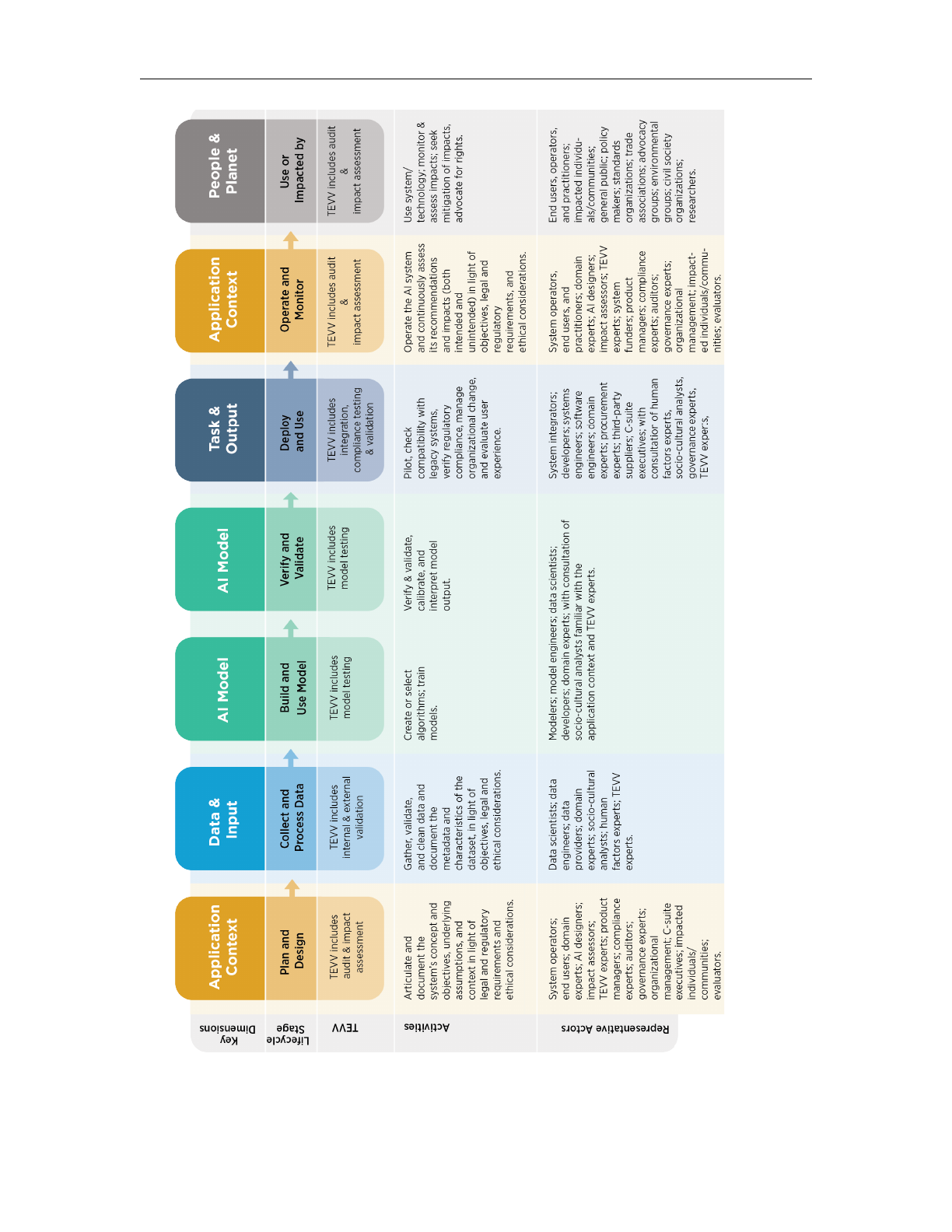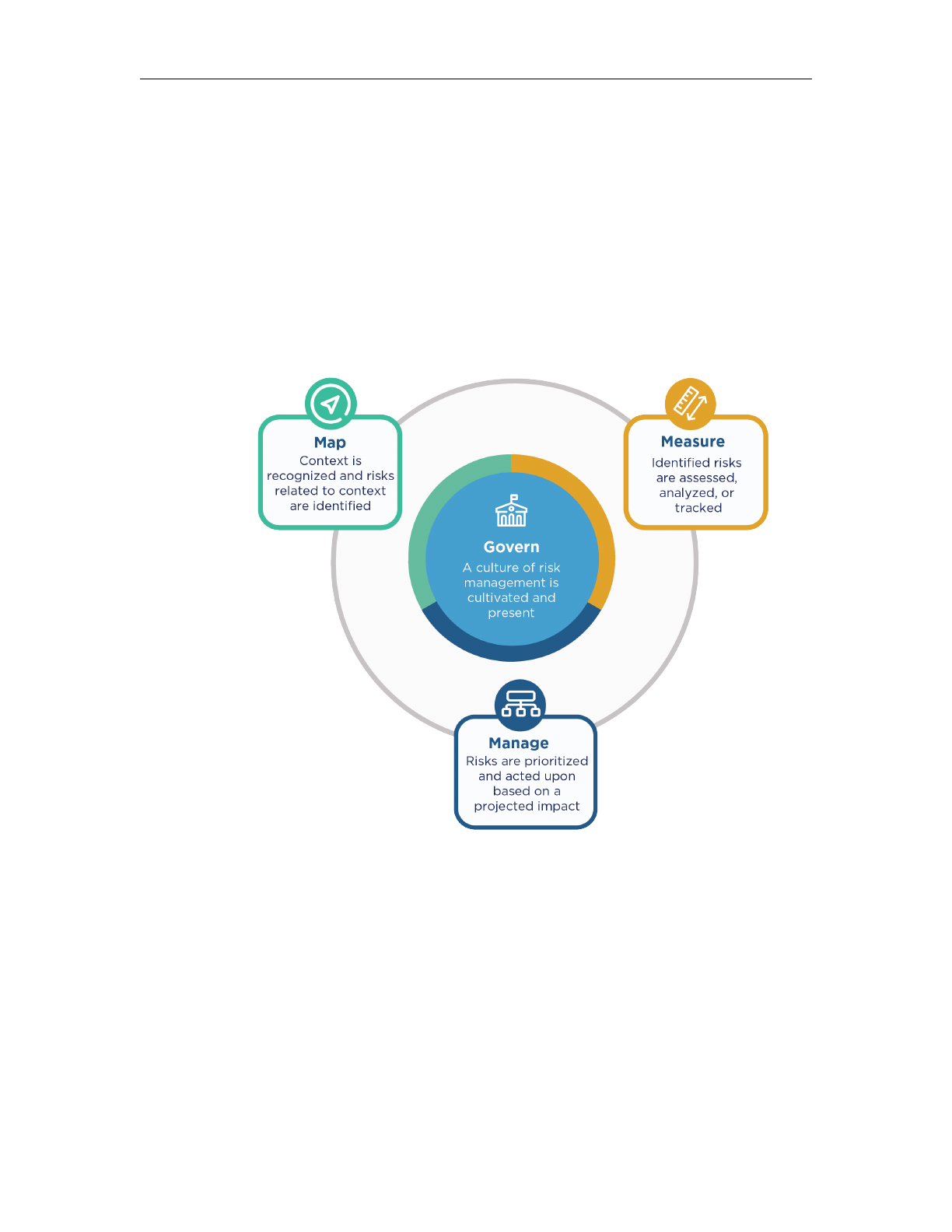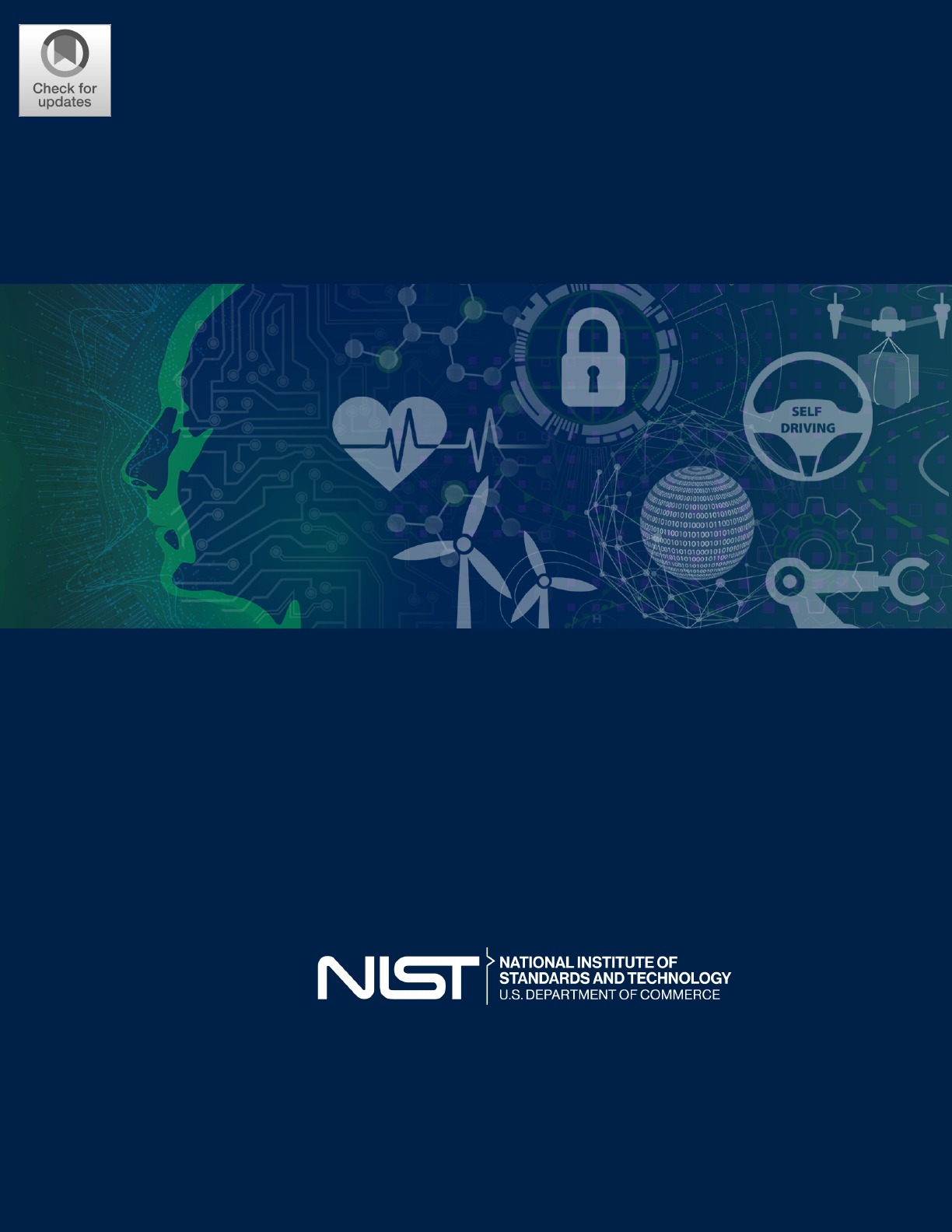
NIST AI 100-1
Artificial Intelligence Risk Management
Framework (AI RMF 1.0)
This publication is available free of charge from:
https://doi.org/10.6028/NIST.AI.100-1
January 2023
U.S. Department of Commerce
Gina M. Raimondo, Secretary
National Institute of Standards and Technology
Laurie E. Locascio, NIST Director and Under Secretary of Commerce for Standards and Technology

Certain commercial entities, equipment, or materials may be identified in this document in order to describe
an experimental procedure or concept adequately. Such identification is not intended to imply recommenda-
tion or endorsement by the National Institute of Standards and Technology, nor is it intended to imply that
the entities, materials, or equipment are necessarily the best available for the purpose.
This publication is available free of charge from: https://doi.org/10.6028/NIST.AI.100-1
Update Schedule and Versions
The Artificial Intelligence Risk Management Framework (AI RMF) is intended to be a living document.
NIST will review the content and usefulness of the Framework regularly to determine if an update is appro-
priate; a review with formal input from the AI community is expected to take place no later than 2028. The
Framework will employ a two-number versioning system to track and identify major and minor changes. The
first number will represent the generation of the AI RMF and its companion documents (e.g., 1.0) and will
change only with major revisions. Minor revisions will be tracked using “.n” after the generation number
(e.g., 1.1). All changes will be tracked using a Version Control Table which identifies the history, including
version number, date of change, and description of change. NIST plans to update the AI RMF Playbook
frequently. Comments on the AI RMF Playbook may be sent via email to AIframew[email protected] at any time
and will be reviewed and integrated on a semi-annual basis.

Table of Contents
Executive Summary 1
Part 1: Foundational Information 4
1 Framing Risk 4
1.1 Understanding and Addressing Risks, Impacts, and Harms 4
1.2 Challenges for AI Risk Management 5
1.2.1 Risk Measurement 5
1.2.2 Risk Tolerance 7
1.2.3 Risk Prioritization 7
1.2.4 Organizational Integration and Management of Risk 8
2 Audience 9
3 AI Risks and Trustworthiness 12
3.1 Valid and Reliable 13
3.2 Safe 14
3.3 Secure and Resilient 15
3.4 Accountable and Transparent 15
3.5 Explainable and Interpretable 16
3.6 Privacy-Enhanced 17
3.7 Fair – with Harmful Bias Managed 17
4 Effectiveness of the AI RMF 19
Part 2: Core and Profiles 20
5 AI RMF Core 20
5.1 Govern 21
5.2 Map 24
5.3 Measure 28
5.4 Manage 31
6 AI RMF Profiles 33
Appendix A: Descriptions of AI Actor Tasks from Figures 2 and 3 35
Appendix B: How AI Risks Differ from Traditional Software Risks 38
Appendix C: AI Risk Management and Human-AI Interaction 40
Appendix D: Attributes of the AI RMF 42
List of Tables
Table 1 Categories and subcategories for the GOVERN function. 22
Table 2 Categories and subcategories for the MAP function. 26
Table 3 Categories and subcategories for the MEASURE function. 29
Table 4 Categories and subcategories for the MANAGE function. 32
i

NIST AI 100-1 AI RMF 1.0
List of Figures
Fig. 1 Examples of potential harms related to AI systems. Trustworthy AI systems
and their responsible use can mitigate negative risks and contribute to bene-
fits for people, organizations, and ecosystems. 5
Fig. 2 Lifecycle and Key Dimensions of an AI System. Modified from OECD
(2022) OECD Framework for the Classification of AI systems — OECD
Digital Economy Papers. The two inner circles show AI systems’ key di-
mensions and the outer circle shows AI lifecycle stages. Ideally, risk man-
agement efforts start with the Plan and Design function in the application
context and are performed throughout the AI system lifecycle. See Figure 3
for representative AI actors. 10
Fig. 3 AI actors across AI lifecycle stages. See Appendix A for detailed descrip-
tions of AI actor tasks, including details about testing, evaluation, verifica-
tion, and validation tasks. Note that AI actors in the AI Model dimension
(Figure 2) are separated as a best practice, with those building and using the
models separated from those verifying and validating the models. 11
Fig. 4 Characteristics of trustworthy AI systems. Valid & Reliable is a necessary
condition of trustworthiness and is shown as the base for other trustworthi-
ness characteristics. Accountable & Transparent is shown as a vertical box
because it relates to all other characteristics. 12
Fig. 5 Functions organize AI risk management activities at their highest level to
govern, map, measure, and manage AI risks. Governance is designed to be
a cross-cutting function to inform and be infused throughout the other three
functions. 20
Page ii

NIST AI 100-1 AI RMF 1.0
Executive Summary
Artificial intelligence (AI) technologies have significant potential to transform society and
people’s lives – from commerce and health to transportation and cybersecurity to the envi-
ronment and our planet. AI technologies can drive inclusive economic growth and support
scientific advancements that improve the conditions of our world. AI technologies, how-
ever, also pose risks that can negatively impact individuals, groups, organizations, commu-
nities, society, the environment, and the planet. Like risks for other types of technology, AI
risks can emerge in a variety of ways and can be characterized as long- or short-term, high-
or low-probability, systemic or localized, and high- or low-impact.
The AI RMF refers to an AI system as an engineered or machine-based system that
can, for a given set of objectives, generate outputs such as predictions, recommenda-
tions, or decisions influencing real or virtual environments. AI systems are designed
to operate with varying levels of autonomy (Adapted from: OECD Recommendation
on AI:2019; ISO/IEC 22989:2022).
While there are myriad standards and best practices to help organizations mitigate the risks
of traditional software or information-based systems, the risks posed by AI systems are in
many ways unique (See Appendix B). AI systems, for example, may be trained on data that
can change over time, sometimes significantly and unexpectedly, affecting system function-
ality and trustworthiness in ways that are hard to understand. AI systems and the contexts
in which they are deployed are frequently complex, making it difficult to detect and respond
to failures when they occur. AI systems are inherently socio-technical in nature, meaning
they are influenced by societal dynamics and human behavior. AI risks – and benefits –
can emerge from the interplay of technical aspects combined with societal factors related
to how a system is used, its interactions with other AI systems, who operates it, and the
social context in which it is deployed.
These risks make AI a uniquely challenging technology to deploy and utilize both for orga-
nizations and within society. Without proper controls, AI systems can amplify, perpetuate,
or exacerbate inequitable or undesirable outcomes for individuals and communities. With
proper controls, AI systems can mitigate and manage inequitable outcomes.
AI risk management is a key component of responsible development and use of AI sys-
tems. Responsible AI practices can help align the decisions about AI system design, de-
velopment, and uses with intended aim and values. Core concepts in responsible AI em-
phasize human centricity, social responsibility, and sustainability. AI risk management can
drive responsible uses and practices by prompting organizations and their internal teams
who design, develop, and deploy AI to think more critically about context and potential
or unexpected negative and positive impacts. Understanding and managing the risks of AI
systems will help to enhance trustworthiness, and in turn, cultivate public trust.
Page 1

NIST AI 100-1 AI RMF 1.0
Social responsibility can refer to the organization’s responsibility “for the impacts
of its decisions and activities on society and the environment through transparent
and ethical behavior” (ISO 26000:2010). Sustainability refers to the “state of the
global system, including environmental, social, and economic aspects, in which the
needs of the present are met without compromising the ability of future generations
to meet their own needs” (ISO/IEC TR 24368:2022). Responsible AI is meant to
result in technology that is also equitable and accountable. The expectation is that
organizational practices are carried out in accord with “professional responsibility,”
defined by ISO as an approach that “aims to ensure that professionals who design,
develop, or deploy AI systems and applications or AI-based products or systems,
recognize their unique position to exert influence on people, society, and the future
of AI” (ISO/IEC TR 24368:2022).
As directed by the National Artificial Intelligence Initiative Act of 2020 (P.L. 116-283),
the goal of the AI RMF is to offer a resource to the organizations designing, developing,
deploying, or using AI systems to help manage the many risks of AI and promote trustwor-
thy and responsible development and use of AI systems. The Framework is intended to be
voluntary, rights-preserving, non-sector-specific, and use-case agnostic, providing flexibil-
ity to organizations of all sizes and in all sectors and throughout society to implement the
approaches in the Framework.
The Framework is designed to equip organizations and individuals – referred to here as
AI actors – with approaches that increase the trustworthiness of AI systems, and to help
foster the responsible design, development, deployment, and use of AI systems over time.
AI actors are defined by the Organisation for Economic Co-operation and Development
(OECD) as “those who play an active role in the AI system lifecycle, including organiza-
tions and individuals that deploy or operate AI” [OECD (2019) Artificial Intelligence in
Society—OECD iLibrary] (See Appendix A).
The AI RMF is intended to be practical, to adapt to the AI landscape as AI technologies
continue to develop, and to be operationalized by organizations in varying degrees and
capacities so society can benefit from AI while also being protected from its potential
harms.
The Framework and supporting resources will be updated, expanded, and improved based
on evolving technology, the standards landscape around the world, and AI community ex-
perience and feedback. NIST will continue to align the AI RMF and related guidance with
applicable international standards, guidelines, and practices. As the AI RMF is put into
use, additional lessons will be learned to inform future updates and additional resources.
The Framework is divided into two parts. Part 1 discusses how organizations can frame
the risks related to AI and describes the intended audience. Next, AI risks and trustworthi-
ness are analyzed, outlining the characteristics of trustworthy AI systems, which include
Page 2

NIST AI 100-1 AI RMF 1.0
valid and reliable, safe, secure and resilient, accountable and transparent, explainable and
interpretable, privacy enhanced, and fair with their harmful biases managed.
Part 2 comprises the “Core” of the Framework. It describes four specific functions to help
organizations address the risks of AI systems in practice. These functions – GOVERN,
MAP, MEASURE, and MANAGE – are broken down further into categories and subcate-
gories. While GOVERN applies to all stages of organizations’ AI risk management pro-
cesses and procedures, the MAP, MEASURE, and MANAGE functions can be applied in AI
system-specific contexts and at specific stages of the AI lifecycle.
Additional resources related to the Framework are included in the AI RMF Playbook,
which is available via the NIST AI RMF website:
https://www.nist.gov/itl/ai-risk-management-framework.
Development of the AI RMF by NIST in collaboration with the private and public sec-
tors is directed and consistent with its broader AI efforts called for by the National AI
Initiative Act of 2020, the National Security Commission on Artificial Intelligence recom-
mendations, and the Plan for Federal Engagement in Developing Technical Standards and
Related Tools. Engagement with the AI community during this Framework’s development
– via responses to a formal Request for Information, three widely attended workshops,
public comments on a concept paper and two drafts of the Framework, discussions at mul-
tiple public forums, and many small group meetings – has informed development of the AI
RMF 1.0 as well as AI research and development and evaluation conducted by NIST and
others. Priority research and additional guidance that will enhance this Framework will be
captured in an associated AI Risk Management Framework Roadmap to which NIST and
the broader community can contribute.
Page 3

NIST AI 100-1 AI RMF 1.0
Part 1: Foundational Information
1. Framing Risk
AI risk management offers a path to minimize potential negative impacts of AI systems,
such as threats to civil liberties and rights, while also providing opportunities to maximize
positive impacts. Addressing, documenting, and managing AI risks and potential negative
impacts effectively can lead to more trustworthy AI systems.
1.1 Understanding and Addressing Risks, Impacts, and Harms
In the context of the AI RMF, risk refers to the composite measure of an event’s probability
of occurring and the magnitude or degree of the consequences of the corresponding event.
The impacts, or consequences, of AI systems can be positive, negative, or both and can
result in opportunities or threats (Adapted from: ISO 31000:2018). When considering the
negative impact of a potential event, risk is a function of 1) the negative impact, or magni-
tude of harm, that would arise if the circumstance or event occurs and 2) the likelihood of
occurrence (Adapted from: OMB Circular A-130:2016). Negative impact or harm can be
experienced by individuals, groups, communities, organizations, society, the environment,
and the planet.
“Risk management refers to coordinated activities to direct and control an organiza-
tion with regard to risk” (Source: ISO 31000:2018).
While risk management processes generally address negative impacts, this Framework of-
fers approaches to minimize anticipated negative impacts of AI systems and identify op-
portunities to maximize positive impacts. Effectively managing the risk of potential harms
could lead to more trustworthy AI systems and unleash potential benefits to people (individ-
uals, communities, and society), organizations, and systems/ecosystems. Risk management
can enable AI developers and users to understand impacts and account for the inherent lim-
itations and uncertainties in their models and systems, which in turn can improve overall
system performance and trustworthiness and the likelihood that AI technologies will be
used in ways that are beneficial.
The AI RMF is designed to address new risks as they emerge. This flexibility is particularly
important where impacts are not easily foreseeable and applications are evolving. While
some AI risks and benefits are well-known, it can be challenging to assess negative impacts
and the degree of harms. Figure 1 provides examples of potential harms that can be related
to AI systems.
AI risk management efforts should consider that humans may assume that AI systems work
– and work well – in all settings. For example, whether correct or not, AI systems are
often perceived as being more objective than humans or as offering greater capabilities
than general software.
Page 4

NIST AI 100-1 AI RMF 1.0
Fig. 1. Examples of potential harms related to AI systems. Trustworthy AI systems and their
responsible use can mitigate negative risks and contribute to benefits for people, organizations, and
ecosystems.
1.2 Challenges for AI Risk Management
Several challenges are described below. They should be taken into account when managing
risks in pursuit of AI trustworthiness.
1.2.1 Risk Measurement
AI risks or failures that are not well-defined or adequately understood are difficult to mea-
sure quantitatively or qualitatively. The inability to appropriately measure AI risks does not
imply that an AI system necessarily poses either a high or low risk. Some risk measurement
challenges include:
Risks related to third-party software, hardware, and data: Third-party data or systems
can accelerate research and development and facilitate technology transition. They also
may complicate risk measurement. Risk can emerge both from third-party data, software or
hardware itself and how it is used. Risk metrics or methodologies used by the organization
developing the AI system may not align with the risk metrics or methodologies uses by
the organization deploying or operating the system. Also, the organization developing
the AI system may not be transparent about the risk metrics or methodologies it used. Risk
measurement and management can be complicated by how customers use or integrate third-
party data or systems into AI products or services, particularly without sufficient internal
governance structures and technical safeguards. Regardless, all parties and AI actors should
manage risk in the AI systems they develop, deploy, or use as standalone or integrated
components.
Tracking emergent risks: Organizations’ risk management efforts will be enhanced by
identifying and tracking emergent risks and considering techniques for measuring them.
Page 5

NIST AI 100-1 AI RMF 1.0
AI system impact assessment approaches can help AI actors understand potential impacts
or harms within specific contexts.
Availability of reliable metrics: The current lack of consensus on robust and verifiable
measurement methods for risk and trustworthiness, and applicability to different AI use
cases, is an AI risk measurement challenge. Potential pitfalls when seeking to measure
negative risk or harms include the reality that development of metrics is often an institu-
tional endeavor and may inadvertently reflect factors unrelated to the underlying impact. In
addition, measurement approaches can be oversimplified, gamed, lack critical nuance, be-
come relied upon in unexpected ways, or fail to account for differences in affected groups
and contexts.
Approaches for measuring impacts on a population work best if they recognize that contexts
matter, that harms may affect varied groups or sub-groups differently, and that communities
or other sub-groups who may be harmed are not always direct users of a system.
Risk at different stages of the AI lifecycle: Measuring risk at an earlier stage in the AI
lifecycle may yield different results than measuring risk at a later stage; some risks may
be latent at a given point in time and may increase as AI systems adapt and evolve. Fur-
thermore, different AI actors across the AI lifecycle can have different risk perspectives.
For example, an AI developer who makes AI software available, such as pre-trained mod-
els, can have a different risk perspective than an AI actor who is responsible for deploying
that pre-trained model in a specific use case. Such deployers may not recognize that their
particular uses could entail risks which differ from those perceived by the initial developer.
All involved AI actors share responsibilities for designing, developing, and deploying a
trustworthy AI system that is fit for purpose.
Risk in real-world settings: While measuring AI risks in a laboratory or a controlled
environment may yield important insights pre-deployment, these measurements may differ
from risks that emerge in operational, real-world settings.
Inscrutability: Inscrutable AI systems can complicate risk measurement. Inscrutability
can be a result of the opaque nature of AI systems (limited explainability or interpretabil-
ity), lack of transparency or documentation in AI system development or deployment, or
inherent uncertainties in AI systems.
Human baseline: Risk management of AI systems that are intended to augment or replace
human activity, for example decision making, requires some form of baseline metrics for
comparison. This is difficult to systematize since AI systems carry out different tasks – and
perform tasks differently – than humans.
Page 6

NIST AI 100-1 AI RMF 1.0
1.2.2 Risk Tolerance
While the AI RMF can be used to prioritize risk, it does not prescribe risk tolerance. Risk
tolerance refers to the organization’s or AI actor’s (see Appendix A) readiness to bear the
risk in order to achieve its objectives. Risk tolerance can be influenced by legal or regula-
tory requirements (Adapted from: ISO GUIDE 73). Risk tolerance and the level of risk that
is acceptable to organizations or society are highly contextual and application and use-case
specific. Risk tolerances can be influenced by policies and norms established by AI sys-
tem owners, organizations, industries, communities, or policy makers. Risk tolerances are
likely to change over time as AI systems, policies, and norms evolve. Different organiza-
tions may have varied risk tolerances due to their particular organizational priorities and
resource considerations.
Emerging knowledge and methods to better inform harm/cost-benefit tradeoffs will con-
tinue to be developed and debated by businesses, governments, academia, and civil society.
To the extent that challenges for specifying AI risk tolerances remain unresolved, there may
be contexts where a risk management framework is not yet readily applicable for mitigating
negative AI risks.
The Framework is intended to be flexible and to augment existing risk practices
which should align with applicable laws, regulations, and norms. Organizations
should follow existing regulations and guidelines for risk criteria, tolerance, and
response established by organizational, domain, discipline, sector, or professional
requirements. Some sectors or industries may have established definitions of harm or
established documentation, reporting, and disclosure requirements. Within sectors,
risk management may depend on existing guidelines for specific applications and
use case settings. Where established guidelines do not exist, organizations should
define reasonable risk tolerance. Once tolerance is defined, this AI RMF can be used
to manage risks and to document risk management processes.
1.2.3 Risk Prioritization
Attempting to eliminate negative risk entirely can be counterproductive in practice because
not all incidents and failures can be eliminated. Unrealistic expectations about risk may
lead organizations to allocate resources in a manner that makes risk triage inefficient or
impractical or wastes scarce resources. A risk management culture can help organizations
recognize that not all AI risks are the same, and resources can be allocated purposefully.
Actionable risk management efforts lay out clear guidelines for assessing trustworthiness
of each AI system an organization develops or deploys. Policies and resources should be
prioritized based on the assessed risk level and potential impact of an AI system. The extent
to which an AI system may be customized or tailored to the specific context of use by the
AI deployer can be a contributing factor.
Page 7

NIST AI 100-1 AI RMF 1.0
When applying the AI RMF, risks which the organization determines to be highest for the
AI systems within a given context of use call for the most urgent prioritization and most
thorough risk management process. In cases where an AI system presents unacceptable
negative risk levels – such as where significant negative impacts are imminent, severe harms
are actually occurring, or catastrophic risks are present – development and deployment
should cease in a safe manner until risks can be sufficiently managed. If an AI system’s
development, deployment, and use cases are found to be low-risk in a specific context, that
may suggest potentially lower prioritization.
Risk prioritization may differ between AI systems that are designed or deployed to directly
interact with humans as compared to AI systems that are not. Higher initial prioritization
may be called for in settings where the AI system is trained on large datasets comprised of
sensitive or protected data such as personally identifiable information, or where the outputs
of the AI systems have direct or indirect impact on humans. AI systems designed to interact
only with computational systems and trained on non-sensitive datasets (for example, data
collected from the physical environment) may call for lower initial prioritization. Nonethe-
less, regularly assessing and prioritizing risk based on context remains important because
non-human-facing AI systems can have downstream safety or social implications.
Residual risk – defined as risk remaining after risk treatment (Source: ISO GUIDE 73) –
directly impacts end users or affected individuals and communities. Documenting residual
risks will call for the system provider to fully consider the risks of deploying the AI product
and will inform end users about potential negative impacts of interacting with the system.
1.2.4 Organizational Integration and Management of Risk
AI risks should not be considered in isolation. Different AI actors have different responsi-
bilities and awareness depending on their roles in the lifecycle. For example, organizations
developing an AI system often will not have information about how the system may be
used. AI risk management should be integrated and incorporated into broader enterprise
risk management strategies and processes. Treating AI risks along with other critical risks,
such as cybersecurity and privacy, will yield a more integrated outcome and organizational
efficiencies.
The AI RMF may be utilized along with related guidance and frameworks for managing
AI system risks or broader enterprise risks. Some risks related to AI systems are common
across other types of software development and deployment. Examples of overlapping risks
include: privacy concerns related to the use of underlying data to train AI systems; the en-
ergy and environmental implications associated with resource-heavy computing demands;
security concerns related to the confidentiality, integrity, and availability of the system and
its training and output data; and general security of the underlying software and hardware
for AI systems.
Page 8

NIST AI 100-1 AI RMF 1.0
Organizations need to establish and maintain the appropriate accountability mechanisms,
roles and responsibilities, culture, and incentive structures for risk management to be ef-
fective. Use of the AI RMF alone will not lead to these changes or provide the appropriate
incentives. Effective risk management is realized through organizational commitment at
senior levels and may require cultural change within an organization or industry. In addi-
tion, small to medium-sized organizations managing AI risks or implementing the AI RMF
may face different challenges than large organizations, depending on their capabilities and
resources.
2. Audience
Identifying and managing AI risks and potential impacts – both positive and negative – re-
quires a broad set of perspectives and actors across the AI lifecycle. Ideally, AI actors will
represent a diversity of experience, expertise, and backgrounds and comprise demograph-
ically and disciplinarily diverse teams. The AI RMF is intended to be used by AI actors
across the AI lifecycle and dimensions.
The OECD has developed a framework for classifying AI lifecycle activities according to
five key socio-technical dimensions, each with properties relevant for AI policy and gover-
nance, including risk management [OECD (2022) OECD Framework for the Classification
of AI systems — OECD Digital Economy Papers]. Figure 2 shows these dimensions,
slightly modified by NIST for purposes of this framework. The NIST modification high-
lights the importance of test, evaluation, verification, and validation (TEVV) processes
throughout an AI lifecycle and generalizes the operational context of an AI system.
AI dimensions displayed in Figure 2 are the Application Context, Data and Input, AI
Model, and Task and Output. AI actors involved in these dimensions who perform or
manage the design, development, deployment, evaluation, and use of AI systems and drive
AI risk management efforts are the primary AI RMF audience.
Representative AI actors across the lifecycle dimensions are listed in Figure 3 and described
in detail in Appendix A. Within the AI RMF, all AI actors work together to manage risks
and achieve the goals of trustworthy and responsible AI. AI actors with TEVV-specific
expertise are integrated throughout the AI lifecycle and are especially likely to benefit from
the Framework. Performed regularly, TEVV tasks can provide insights relative to technical,
societal, legal, and ethical standards or norms, and can assist with anticipating impacts and
assessing and tracking emergent risks. As a regular process within an AI lifecycle, TEVV
allows for both mid-course remediation and post-hoc risk management.
The People & Planet dimension at the center of Figure 2 represents human rights and the
broader well-being of society and the planet. The AI actors in this dimension comprise
a separate AI RMF audience who informs the primary audience. These AI actors may in-
clude trade associations, standards developing organizations, researchers, advocacy groups,
Page 9

NIST AI 100-1 AI RMF 1.0
Fig. 2. Lifecycle and Key Dimensions of an AI System. Modified from OECD (2022) OECD
Framework for the Classification of AI systems — OECD Digital Economy Papers. The two inner
circles show AI systems’ key dimensions and the outer circle shows AI lifecycle stages. Ideally,
risk management efforts start with the Plan and Design function in the application context and are
performed throughout the AI system lifecycle. See Figure 3 for representative AI actors.
environmental groups, civil society organizations, end users, and potentially impacted in-
dividuals and communities. These actors can:
• assist in providing context and understanding potential and actual impacts;
• be a source of formal or quasi-formal norms and guidance for AI risk management;
• designate boundaries for AI operation (technical, societal, legal, and ethical); and
• promote discussion of the tradeoffs needed to balance societal values and priorities
related to civil liberties and rights, equity, the environment and the planet, and the
economy.
Successful risk management depends upon a sense of collective responsibility among AI
actors shown in Figure 3. The AI RMF functions, described in Section 5, require diverse
perspectives, disciplines, professions, and experiences. Diverse teams contribute to more
open sharing of ideas and assumptions about the purposes and functions of technology –
making these implicit aspects more explicit. This broader collective perspective creates
opportunities for surfacing problems and identifying existing and emergent risks.
Page 10

NIST AI 100-1 AI RMF 1.0
Fig. 3. AI actors across AI lifecycle stages. See Appendix A for detailed descriptions of AI actor tasks, including details about testing,
evaluation, verification, and validation tasks. Note that AI actors in the AI Model dimension (Figure 2) are separated as a best practice, with
those building and using the models separated from those verifying and validating the models.
Page 11

NIST AI 100-1 AI RMF 1.0
3. AI Risks and Trustworthiness
For AI systems to be trustworthy, they often need to be responsive to a multiplicity of cri-
teria that are of value to interested parties. Approaches which enhance AI trustworthiness
can reduce negative AI risks. This Framework articulates the following characteristics of
trustworthy AI and offers guidance for addressing them. Characteristics of trustworthy AI
systems include: valid and reliable, safe, secure and resilient, accountable and trans-
parent, explainable and interpretable, privacy-enhanced, and fair with harmful bias
managed. Creating trustworthy AI requires balancing each of these characteristics based
on the AI system’s context of use. While all characteristics are socio-technical system at-
tributes, accountability and transparency also relate to the processes and activities internal
to an AI system and its external setting. Neglecting these characteristics can increase the
probability and magnitude of negative consequences.
Fig. 4. Characteristics of trustworthy AI systems. Valid & Reliable is a necessary condition of
trustworthiness and is shown as the base for other trustworthiness characteristics. Accountable &
Transparent is shown as a vertical box because it relates to all other characteristics.
Trustworthiness characteristics (shown in Figure 4) are inextricably tied to social and orga-
nizational behavior, the datasets used by AI systems, selection of AI models and algorithms
and the decisions made by those who build them, and the interactions with the humans who
provide insight from and oversight of such systems. Human judgment should be employed
when deciding on the specific metrics related to AI trustworthiness characteristics and the
precise threshold values for those metrics.
Addressing AI trustworthiness characteristics individually will not ensure AI system trust-
worthiness; tradeoffs are usually involved, rarely do all characteristics apply in every set-
ting, and some will be more or less important in any given situation. Ultimately, trustwor-
thiness is a social concept that ranges across a spectrum and is only as strong as its weakest
characteristics.
When managing AI risks, organizations can face difficult decisions in balancing these char-
acteristics. For example, in certain scenarios tradeoffs may emerge between optimizing for
interpretability and achieving privacy. In other cases, organizations might face a tradeoff
between predictive accuracy and interpretability. Or, under certain conditions such as data
sparsity, privacy-enhancing techniques can result in a loss in accuracy, affecting decisions
Page 12

NIST AI 100-1 AI RMF 1.0
about fairness and other values in certain domains. Dealing with tradeoffs requires tak-
ing into account the decision-making context. These analyses can highlight the existence
and extent of tradeoffs between different measures, but they do not answer questions about
how to navigate the tradeoff. Those depend on the values at play in the relevant context and
should be resolved in a manner that is both transparent and appropriately justifiable.
There are multiple approaches for enhancing contextual awareness in the AI lifecycle. For
example, subject matter experts can assist in the evaluation of TEVV findings and work
with product and deployment teams to align TEVV parameters to requirements and de-
ployment conditions. When properly resourced, increasing the breadth and diversity of
input from interested parties and relevant AI actors throughout the AI lifecycle can en-
hance opportunities for informing contextually sensitive evaluations, and for identifying
AI system benefits and positive impacts. These practices can increase the likelihood that
risks arising in social contexts are managed appropriately.
Understanding and treatment of trustworthiness characteristics depends on an AI actor’s
particular role within the AI lifecycle. For any given AI system, an AI designer or developer
may have a different perception of the characteristics than the deployer.
Trustworthiness characteristics explained in this document influence each other.
Highly secure but unfair systems, accurate but opaque and uninterpretable systems,
and inaccurate but secure, privacy-enhanced, and transparent systems are all unde-
sirable. A comprehensive approach to risk management calls for balancing tradeoffs
among the trustworthiness characteristics. It is the joint responsibility of all AI ac-
tors to determine whether AI technology is an appropriate or necessary tool for a
given context or purpose, and how to use it responsibly. The decision to commission
or deploy an AI system should be based on a contextual assessment of trustworthi-
ness characteristics and the relative risks, impacts, costs, and benefits, and informed
by a broad set of interested parties.
3.1 Valid and Reliable
Validation is the “confirmation, through the provision of objective evidence, that the re-
quirements for a specific intended use or application have been fulfilled” (Source: ISO
9000:2015). Deployment of AI systems which are inaccurate, unreliable, or poorly gener-
alized to data and settings beyond their training creates and increases negative AI risks and
reduces trustworthiness.
Reliability is defined in the same standard as the “ability of an item to perform as required,
without failure, for a given time interval, under given conditions” (Source: ISO/IEC TS
5723:2022). Reliability is a goal for overall correctness of AI system operation under the
conditions of expected use and over a given period of time, including the entire lifetime of
the system.
Page 13

NIST AI 100-1 AI RMF 1.0
Accuracy and robustness contribute to the validity and trustworthiness of AI systems, and
can be in tension with one another in AI systems.
Accuracy is defined by ISO/IEC TS 5723:2022 as “closeness of results of observations,
computations, or estimates to the true values or the values accepted as being true.” Mea-
sures of accuracy should consider computational-centric measures (e.g., false positive and
false negative rates), human-AI teaming, and demonstrate external validity (generalizable
beyond the training conditions). Accuracy measurements should always be paired with
clearly defined and realistic test sets – that are representative of conditions of expected use
– and details about test methodology; these should be included in associated documen-
tation. Accuracy measurements may include disaggregation of results for different data
segments.
Robustness or generalizability is defined as the “ability of a system to maintain its level
of performance under a variety of circumstances” (Source: ISO/IEC TS 5723:2022). Ro-
bustness is a goal for appropriate system functionality in a broad set of conditions and
circumstances, including uses of AI systems not initially anticipated. Robustness requires
not only that the system perform exactly as it does under expected uses, but also that it
should perform in ways that minimize potential harms to people if it is operating in an
unexpected setting.
Validity and reliability for deployed AI systems are often assessed by ongoing testing or
monitoring that confirms a system is performing as intended. Measurement of validity,
accuracy, robustness, and reliability contribute to trustworthiness and should take into con-
sideration that certain types of failures can cause greater harm. AI risk management efforts
should prioritize the minimization of potential negative impacts, and may need to include
human intervention in cases where the AI system cannot detect or correct errors.
3.2 Safe
AI systems should “not under defined conditions, lead to a state in which human life,
health, property, or the environment is endangered” (Source: ISO/IEC TS 5723:2022). Safe
operation of AI systems is improved through:
• responsible design, development, and deployment practices;
• clear information to deployers on responsible use of the system;
• responsible decision-making by deployers and end users; and
• explanations and documentation of risks based on empirical evidence of incidents.
Different types of safety risks may require tailored AI risk management approaches based
on context and the severity of potential risks presented. Safety risks that pose a potential
risk of serious injury or death call for the most urgent prioritization and most thorough risk
management process.
Page 14

NIST AI 100-1 AI RMF 1.0
Employing safety considerations during the lifecycle and starting as early as possible with
planning and design can prevent failures or conditions that can render a system dangerous.
Other practical approaches for AI safety often relate to rigorous simulation and in-domain
testing, real-time monitoring, and the ability to shut down, modify, or have human inter-
vention into systems that deviate from intended or expected functionality.
AI safety risk management approaches should take cues from efforts and guidelines for
safety in fields such as transportation and healthcare, and align with existing sector- or
application-specific guidelines or standards.
3.3 Secure and Resilient
AI systems, as well as the ecosystems in which they are deployed, may be said to be re-
silient if they can withstand unexpected adverse events or unexpected changes in their envi-
ronment or use – or if they can maintain their functions and structure in the face of internal
and external change and degrade safely and gracefully when this is necessary (Adapted
from: ISO/IEC TS 5723:2022). Common security concerns relate to adversarial examples,
data poisoning, and the exfiltration of models, training data, or other intellectual property
through AI system endpoints. AI systems that can maintain confidentiality, integrity, and
availability through protection mechanisms that prevent unauthorized access and use may
be said to be secure. Guidelines in the NIST Cybersecurity Framework and Risk Manage-
ment Framework are among those which are applicable here.
Security and resilience are related but distinct characteristics. While resilience is the abil-
ity to return to normal function after an unexpected adverse event, security includes re-
silience but also encompasses protocols to avoid, protect against, respond to, or recover
from attacks. Resilience relates to robustness and goes beyond the provenance of the data
to encompass unexpected or adversarial use (or abuse or misuse) of the model or data.
3.4 Accountable and Transparent
Trustworthy AI depends upon accountability. Accountability presupposes transparency.
Transparency reflects the extent to which information about an AI system and its outputs is
available to individuals interacting with such a system – regardless of whether they are even
aware that they are doing so. Meaningful transparency provides access to appropriate levels
of information based on the stage of the AI lifecycle and tailored to the role or knowledge
of AI actors or individuals interacting with or using the AI system. By promoting higher
levels of understanding, transparency increases confidence in the AI system.
This characteristic’s scope spans from design decisions and training data to model train-
ing, the structure of the model, its intended use cases, and how and when deployment,
post-deployment, or end user decisions were made and by whom. Transparency is often
necessary for actionable redress related to AI system outputs that are incorrect or otherwise
lead to negative impacts. Transparency should consider human-AI interaction: for exam-
Page 15

NIST AI 100-1 AI RMF 1.0
ple, how a human operator or user is notified when a potential or actual adverse outcome
caused by an AI system is detected. A transparent system is not necessarily an accurate,
privacy-enhanced, secure, or fair system. However, it is difficult to determine whether an
opaque system possesses such characteristics, and to do so over time as complex systems
evolve.
The role of AI actors should be considered when seeking accountability for the outcomes of
AI systems. The relationship between risk and accountability associated with AI and tech-
nological systems more broadly differs across cultural, legal, sectoral, and societal contexts.
When consequences are severe, such as when life and liberty are at stake, AI developers
and deployers should consider proportionally and proactively adjusting their transparency
and accountability practices. Maintaining organizational practices and governing structures
for harm reduction, like risk management, can help lead to more accountable systems.
Measures to enhance transparency and accountability should also consider the impact of
these efforts on the implementing entity, including the level of necessary resources and the
need to safeguard proprietary information.
Maintaining the provenance of training data and supporting attribution of the AI system’s
decisions to subsets of training data can assist with both transparency and accountability.
Training data may also be subject to copyright and should follow applicable intellectual
property rights laws.
As transparency tools for AI systems and related documentation continue to evolve, devel-
opers of AI systems are encouraged to test different types of transparency tools in cooper-
ation with AI deployers to ensure that AI systems are used as intended.
3.5 Explainable and Interpretable
Explainability refers to a representation of the mechanisms underlying AI systems’ oper-
ation, whereas interpretability refers to the meaning of AI systems’ output in the context
of their designed functional purposes. Together, explainability and interpretability assist
those operating or overseeing an AI system, as well as users of an AI system, to gain
deeper insights into the functionality and trustworthiness of the system, including its out-
puts. The underlying assumption is that perceptions of negative risk stem from a lack of
ability to make sense of, or contextualize, system output appropriately. Explainable and
interpretable AI systems offer information that will help end users understand the purposes
and potential impact of an AI system.
Risk from lack of explainability may be managed by describing how AI systems function,
with descriptions tailored to individual differences such as the user’s role, knowledge, and
skill level. Explainable systems can be debugged and monitored more easily, and they lend
themselves to more thorough documentation, audit, and governance.
Page 16

NIST AI 100-1 AI RMF 1.0
Risks to interpretability often can be addressed by communicating a description of why
an AI system made a particular prediction or recommendation. (See “Four Principles of
Explainable Artificial Intelligence” and “Psychological Foundations of Explainability and
Interpretability in Artificial Intelligence” found here.)
Transparency, explainability, and interpretability are distinct characteristics that support
each other. Transparency can answer the question of “what happened” in the system. Ex-
plainability can answer the question of “how” a decision was made in the system. Inter-
pretability can answer the question of “why” a decision was made by the system and its
meaning or context to the user.
3.6 Privacy-Enhanced
Privacy refers generally to the norms and practices that help to safeguard human autonomy,
identity, and dignity. These norms and practices typically address freedom from intrusion,
limiting observation, or individuals’ agency to consent to disclosure or control of facets of
their identities (e.g., body, data, reputation). (See The NIST Privacy Framework: A Tool
for Improving Privacy through Enterprise Risk Management.)
Privacy values such as anonymity, confidentiality, and control generally should guide choices
for AI system design, development, and deployment. Privacy-related risks may influence
security, bias, and transparency and come with tradeoffs with these other characteristics.
Like safety and security, specific technical features of an AI system may promote or reduce
privacy. AI systems can also present new risks to privacy by allowing inference to identify
individuals or previously private information about individuals.
Privacy-enhancing technologies (“PETs”) for AI, as well as data minimizing methods such
as de-identification and aggregation for certain model outputs, can support design for
privacy-enhanced AI systems. Under certain conditions such as data sparsity, privacy-
enhancing techniques can result in a loss in accuracy, affecting decisions about fairness
and other values in certain domains.
3.7 Fair – with Harmful Bias Managed
Fairness in AI includes concerns for equality and equity by addressing issues such as harm-
ful bias and discrimination. Standards of fairness can be complex and difficult to define be-
cause perceptions of fairness differ among cultures and may shift depending on application.
Organizations’ risk management efforts will be enhanced by recognizing and considering
these differences. Systems in which harmful biases are mitigated are not necessarily fair.
For example, systems in which predictions are somewhat balanced across demographic
groups may still be inaccessible to individuals with disabilities or affected by the digital
divide or may exacerbate existing disparities or systemic biases.
Page 17

NIST AI 100-1 AI RMF 1.0
Bias is broader than demographic balance and data representativeness. NIST has identified
three major categories of AI bias to be considered and managed: systemic, computational
and statistical, and human-cognitive. Each of these can occur in the absence of prejudice,
partiality, or discriminatory intent. Systemic bias can be present in AI datasets, the orga-
nizational norms, practices, and processes across the AI lifecycle, and the broader society
that uses AI systems. Computational and statistical biases can be present in AI datasets
and algorithmic processes, and often stem from systematic errors due to non-representative
samples. Human-cognitive biases relate to how an individual or group perceives AI sys-
tem information to make a decision or fill in missing information, or how humans think
about purposes and functions of an AI system. Human-cognitive biases are omnipresent
in decision-making processes across the AI lifecycle and system use, including the design,
implementation, operation, and maintenance of AI.
Bias exists in many forms and can become ingrained in the automated systems that help
make decisions about our lives. While bias is not always a negative phenomenon, AI sys-
tems can potentially increase the speed and scale of biases and perpetuate and amplify
harms to individuals, groups, communities, organizations, and society. Bias is tightly asso-
ciated with the concepts of transparency as well as fairness in society. (For more informa-
tion about bias, including the three categories, see NIST Special Publication 1270, Towards
a Standard for Identifying and Managing Bias in Artificial Intelligence.)
Page 18

NIST AI 100-1 AI RMF 1.0
4. Effectiveness of the AI RMF
Evaluations of AI RMF effectiveness – including ways to measure bottom-line improve-
ments in the trustworthiness of AI systems – will be part of future NIST activities, in
conjunction with the AI community.
Organizations and other users of the Framework are encouraged to periodically evaluate
whether the AI RMF has improved their ability to manage AI risks, including but not lim-
ited to their policies, processes, practices, implementation plans, indicators, measurements,
and expected outcomes. NIST intends to work collaboratively with others to develop met-
rics, methodologies, and goals for evaluating the AI RMF’s effectiveness, and to broadly
share results and supporting information. Framework users are expected to benefit from:
• enhanced processes for governing, mapping, measuring, and managing AI risk, and
clearly documenting outcomes;
• improved awareness of the relationships and tradeoffs among trustworthiness char-
acteristics, socio-technical approaches, and AI risks;
• explicit processes for making go/no-go system commissioning and deployment deci-
sions;
• established policies, processes, practices, and procedures for improving organiza-
tional accountability efforts related to AI system risks;
• enhanced organizational culture which prioritizes the identification and management
of AI system risks and potential impacts to individuals, communities, organizations,
and society;
• better information sharing within and across organizations about risks, decision-
making processes, responsibilities, common pitfalls, TEVV practices, and approaches
for continuous improvement;
• greater contextual knowledge for increased awareness of downstream risks;
• strengthened engagement with interested parties and relevant AI actors; and
• augmented capacity for TEVV of AI systems and associated risks.
Page 19

NIST AI 100-1 AI RMF 1.0
Part 2: Core and Profiles
5. AI RMF Core
The AI RMF Core provides outcomes and actions that enable dialogue, understanding, and
activities to manage AI risks and responsibly develop trustworthy AI systems. As illus-
trated in Figure 5, the Core is composed of four functions: GOVERN, MAP, MEASURE,
and MANAGE. Each of these high-level functions is broken down into categories and sub-
categories. Categories and subcategories are subdivided into specific actions and outcomes.
Actions do not constitute a checklist, nor are they necessarily an ordered set of steps.
Fig. 5. Functions organize AI risk management activities at their highest level to govern, map,
measure, and manage AI risks. Governance is designed to be a cross-cutting function to inform
and be infused throughout the other three functions.
Risk management should be continuous, timely, and performed throughout the AI system
lifecycle dimensions. AI RMF Core functions should be carried out in a way that reflects
diverse and multidisciplinary perspectives, potentially including the views of AI actors out-
side the organization. Having a diverse team contributes to more open sharing of ideas and
assumptions about purposes and functions of the technology being designed, developed,
Page 20

NIST AI 100-1 AI RMF 1.0
deployed, or evaluated – which can create opportunities to surface problems and identify
existing and emergent risks.
An online companion resource to the AI RMF, the NIST AI RMF Playbook, is available
to help organizations navigate the AI RMF and achieve its outcomes through suggested
tactical actions they can apply within their own contexts. Like the AI RMF, the Playbook
is voluntary and organizations can utilize the suggestions according to their needs and
interests. Playbook users can create tailored guidance selected from suggested material
for their own use and contribute their suggestions for sharing with the broader community.
Along with the AI RMF, the Playbook is part of the NIST Trustworthy and Responsible AI
Resource Center.
Framework users may apply these functions as best suits their needs for managing
AI risks based on their resources and capabilities. Some organizations may choose
to select from among the categories and subcategories; others may choose and have
the capacity to apply all categories and subcategories. Assuming a governance struc-
ture is in place, functions may be performed in any order across the AI lifecycle as
deemed to add value by a user of the framework. After instituting the outcomes in
GOVERN, most users of the AI RMF would start with the MAP function and con-
tinue to MEASURE or MANAGE. However users integrate the functions, the process
should be iterative, with cross-referencing between functions as necessary. Simi-
larly, there are categories and subcategories with elements that apply to multiple
functions, or that logically should take place before certain subcategory decisions.
5.1 Govern
The GOVERN function:
• cultivates and implements a culture of risk management within organizations design-
ing, developing, deploying, evaluating, or acquiring AI systems;
• outlines processes, documents, and organizational schemes that anticipate, identify,
and manage the risks a system can pose, including to users and others across society
– and procedures to achieve those outcomes;
• incorporates processes to assess potential impacts;
• provides a structure by which AI risk management functions can align with organi-
zational principles, policies, and strategic priorities;
• connects technical aspects of AI system design and development to organizational
values and principles, and enables organizational practices and competencies for the
individuals involved in acquiring, training, deploying, and monitoring such systems;
and
• addresses full product lifecycle and associated processes, including legal and other
issues concerning use of third-party software or hardware systems and data.
Page 21

NIST AI 100-1 AI RMF 1.0
GOVERN is a cross-cutting function that is infused throughout AI risk management and
enables the other functions of the process. Aspects of GOVERN, especially those related to
compliance or evaluation, should be integrated into each of the other functions. Attention
to governance is a continual and intrinsic requirement for effective AI risk management
over an AI system’s lifespan and the organization’s hierarchy.
Strong governance can drive and enhance internal practices and norms to facilitate orga-
nizational risk culture. Governing authorities can determine the overarching policies that
direct an organization’s mission, goals, values, culture, and risk tolerance. Senior leader-
ship sets the tone for risk management within an organization, and with it, organizational
culture. Management aligns the technical aspects of AI risk management to policies and
operations. Documentation can enhance transparency, improve human review processes,
and bolster accountability in AI system teams.
After putting in place the structures, systems, processes, and teams described in the GOV-
ERN function, organizations should benefit from a purpose-driven culture focused on risk
understanding and management. It is incumbent on Framework users to continue to ex-
ecute the GOVERN function as knowledge, cultures, and needs or expectations from AI
actors evolve over time.
Practices related to governing AI risks are described in the NIST AI RMF Playbook. Table
1 lists the GOVERN function’s categories and subcategories.
Table 1: Categories and subcategories for the GOVERN function.
GOVERN 1:
Policies, processes,
procedures, and
practices across the
organization related
to the mapping,
measuring, and
managing of AI
risks are in place,
transparent, and
implemented
effectively.
GOVERN 1.1: Legal and regulatory requirements involving AI
are understood, managed, and documented.
GOVERN 1.2: The characteristics of trustworthy AI are inte-
grated into organizational policies, processes, procedures, and
practices.
GOVERN 1.3: Processes, procedures, and practices are in place
to determine the needed level of risk management activities based
on the organization’s risk tolerance.
GOVERN 1.4: The risk management process and its outcomes are
established through transparent policies, procedures, and other
controls based on organizational risk priorities.
Categories Subcategories
Continued on next page
Page 22

NIST AI 100-1 AI RMF 1.0
Table 1: Categories and subcategories for the GOVERN function. (Continued)
GOVERN 1.5: Ongoing monitoring and periodic review of the
risk management process and its outcomes are planned and or-
ganizational roles and responsibilities clearly defined, including
determining the frequency of periodic review.
GOVERN 1.6: Mechanisms are in place to inventory AI systems
and are resourced according to organizational risk priorities.
GOVERN 1.7: Processes and procedures are in place for decom-
missioning and phasing out AI systems safely and in a man-
ner that does not increase risks or decrease the organization’s
trustworthiness.
GOVERN 2:
Accountability
structures are in
place so that the
appropriate teams
and individuals are
empowered,
responsible, and
trained for mapping,
measuring, and
managing AI risks.
GOVERN 2.1: Roles and responsibilities and lines of communi-
cation related to mapping, measuring, and managing AI risks are
documented and are clear to individuals and teams throughout
the organization.
GOVERN 2.2: The organization’s personnel and partners receive
AI risk management training to enable them to perform their du-
ties and responsibilities consistent with related policies, proce-
dures, and agreements.
GOVERN 2.3: Executive leadership of the organization takes re-
sponsibility for decisions about risks associated with AI system
development and deployment.
GOVERN 3:
Workforce diversity,
equity, inclusion,
and accessibility
processes are
prioritized in the
mapping,
measuring, and
managing of AI
risks throughout the
lifecycle.
GOVERN 3.1: Decision-making related to mapping, measuring,
and managing AI risks throughout the lifecycle is informed by a
diverse team (e.g., diversity of demographics, disciplines, expe-
rience, expertise, and backgrounds).
GOVERN 3.2: Policies and procedures are in place to define and
differentiate roles and responsibilities for human-AI configura-
tions and oversight of AI systems.
GOVERN 4:
Organizational
teams are committed
to a culture
GOVERN 4.1: Organizational policies and practices are in place
to foster a critical thinking and safety-first mindset in the design,
development, deployment, and uses of AI systems to minimize
potential negative impacts.
Categories Subcategories
Continued on next page
Page 23

NIST AI 100-1 AI RMF 1.0
Table 1: Categories and subcategories for the GOVERN function. (Continued)
that considers and
communicates AI
risk.
GOVERN 4.2: Organizational teams document the risks and po-
tential impacts of the AI technology they design, develop, deploy,
evaluate, and use, and they communicate about the impacts more
broadly.
GOVERN 4.3: Organizational practices are in place to enable AI
testing, identification of incidents, and information sharing.
GOVERN 5:
Processes are in
place for robust
engagement with
relevant AI actors.
GOVERN 5.1: Organizational policies and practices are in place
to collect, consider, prioritize, and integrate feedback from those
external to the team that developed or deployed the AI system
regarding the potential individual and societal impacts related to
AI risks.
GOVERN 5.2: Mechanisms are established to enable the team
that developed or deployed AI systems to regularly incorporate
adjudicated feedback from relevant AI actors into system design
and implementation.
GOVERN 6: Policies
and procedures are
in place to address
AI risks and benefits
arising from
third-party software
and data and other
supply chain issues.
GOVERN 6.1: Policies and procedures are in place that address
AI risks associated with third-party entities, including risks of in-
fringement of a third-party’s intellectual property or other rights.
GOVERN 6.2: Contingency processes are in place to handle
failures or incidents in third-party data or AI systems deemed to
be high-risk.
Categories Subcategories
5.2 Map
The MAP function establishes the context to frame risks related to an AI system. The AI
lifecycle consists of many interdependent activities involving a diverse set of actors (See
Figure 3). In practice, AI actors in charge of one part of the process often do not have full
visibility or control over other parts and their associated contexts. The interdependencies
between these activities, and among the relevant AI actors, can make it difficult to reliably
anticipate impacts of AI systems. For example, early decisions in identifying purposes and
objectives of an AI system can alter its behavior and capabilities, and the dynamics of de-
ployment setting (such as end users or impacted individuals) can shape the impacts of AI
system decisions. As a result, the best intentions within one dimension of the AI lifecycle
can be undermined via interactions with decisions and conditions in other, later activities.
Page 24

NIST AI 100-1 AI RMF 1.0
This complexity and varying levels of visibility can introduce uncertainty into risk man-
agement practices. Anticipating, assessing, and otherwise addressing potential sources of
negative risk can mitigate this uncertainty and enhance the integrity of the decision process.
The information gathered while carrying out the MAP function enables negative risk pre-
vention and informs decisions for processes such as model management, as well as an
initial decision about appropriateness or the need for an AI solution. Outcomes in the
MAP function are the basis for the MEASURE and MANAGE functions. Without contex-
tual knowledge, and awareness of risks within the identified contexts, risk management is
difficult to perform. The MAP function is intended to enhance an organization’s ability to
identify risks and broader contributing factors.
Implementation of this function is enhanced by incorporating perspectives from a diverse
internal team and engagement with those external to the team that developed or deployed
the AI system. Engagement with external collaborators, end users, potentially impacted
communities, and others may vary based on the risk level of a particular AI system, the
makeup of the internal team, and organizational policies. Gathering such broad perspec-
tives can help organizations proactively prevent negative risks and develop more trustwor-
thy AI systems by:
• improving their capacity for understanding contexts;
• checking their assumptions about context of use;
• enabling recognition of when systems are not functional within or out of their in-
tended context;
• identifying positive and beneficial uses of their existing AI systems;
• improving understanding of limitations in AI and ML processes;
• identifying constraints in real-world applications that may lead to negative impacts;
• identifying known and foreseeable negative impacts related to intended use of AI
systems; and
• anticipating risks of the use of AI systems beyond intended use.
After completing the MAP function, Framework users should have sufficient contextual
knowledge about AI system impacts to inform an initial go/no-go decision about whether
to design, develop, or deploy an AI system. If a decision is made to proceed, organizations
should utilize the MEASURE and MANAGE functions along with policies and procedures
put into place in the GOVERN function to assist in AI risk management efforts. It is incum-
bent on Framework users to continue applying the MAP function to AI systems as context,
capabilities, risks, benefits, and potential impacts evolve over time.
Practices related to mapping AI risks are described in the NIST AI RMF Playbook. Table
2 lists the MAP function’s categories and subcategories.
Page 25

NIST AI 100-1 AI RMF 1.0
Table 2: Categories and subcategories for the MAP function.
MAP 1: Context is
established and
understood.
MAP 1.1: Intended purposes, potentially beneficial uses, context-
specific laws, norms and expectations, and prospective settings in
which the AI system will be deployed are understood and docu-
mented. Considerations include: the specific set or types of users
along with their expectations; potential positive and negative im-
pacts of system uses to individuals, communities, organizations,
society, and the planet; assumptions and related limitations about
AI system purposes, uses, and risks across the development or
product AI lifecycle; and related TEVV and system metrics.
MAP 1.2: Interdisciplinary AI actors, competencies, skills, and
capacities for establishing context reflect demographic diversity
and broad domain and user experience expertise, and their par-
ticipation is documented. Opportunities for interdisciplinary col-
laboration are prioritized.
MAP 1.3: The organization’s mission and relevant goals for AI
technology are understood and documented.
MAP 1.4: The business value or context of business use has been
clearly defined or – in the case of assessing existing AI systems
– re-evaluated.
MAP 1.5: Organizational risk tolerances are determined and
documented.
MAP 1.6: System requirements (e.g., “the system shall respect
the privacy of its users”) are elicited from and understood by rel-
evant AI actors. Design decisions take socio-technical implica-
tions into account to address AI risks.
MAP 2:
Categorization of
the AI system is
performed.
MAP 2.1: The specific tasks and methods used to implement the
tasks that the AI system will support are defined (e.g., classifiers,
generative models, recommenders).
MAP 2.2: Information about the AI system’s knowledge limits
and how system output may be utilized and overseen by humans
is documented. Documentation provides sufficient information
to assist relevant AI actors when making decisions and taking
subsequent actions.
Categories Subcategories
Continued on next page
Page 26

NIST AI 100-1 AI RMF 1.0
Table 2: Categories and subcategories for the MAP function. (Continued)
MAP 2.3: Scientific integrity and TEVV considerations are iden-
tified and documented, including those related to experimental
design, data collection and selection (e.g., availability, repre-
sentativeness, suitability), system trustworthiness, and construct
validation.
MAP 3: AI
capabilities, targeted
usage, goals, and
expected benefits
and costs compared
with appropriate
benchmarks are
understood.
MAP 3.1: Potential benefits of intended AI system functionality
and performance are examined and documented.
MAP 3.2: Potential costs, including non-monetary costs, which
result from expected or realized AI errors or system functionality
and trustworthiness – as connected to organizational risk toler-
ance – are examined and documented.
MAP 3.3: Targeted application scope is specified and docu-
mented based on the system’s capability, established context, and
AI system categorization.
MAP 3.4: Processes for operator and practitioner proficiency
with AI system performance and trustworthiness – and relevant
technical standards and certifications – are defined, assessed, and
documented.
MAP 3.5: Processes for human oversight are defined, assessed,
and documented in accordance with organizational policies from
the GOVERN function.
MAP 4: Risks and
benefits are mapped
for all components
of the AI system
including third-party
software and data.
MAP 4.1: Approaches for mapping AI technology and legal risks
of its components – including the use of third-party data or soft-
ware – are in place, followed, and documented, as are risks of in-
fringement of a third party’s intellectual property or other rights.
MAP 4.2: Internal risk controls for components of the AI sys-
tem, including third-party AI technologies, are identified and
documented.
MAP 5: Impacts to
individuals, groups,
communities,
organizations, and
society are
characterized.
MAP 5.1: Likelihood and magnitude of each identified impact
(both potentially beneficial and harmful) based on expected use,
past uses of AI systems in similar contexts, public incident re-
ports, feedback from those external to the team that developed
or deployed the AI system, or other data are identified and
documented.
Categories Subcategories
Continued on next page
Page 27

NIST AI 100-1 AI RMF 1.0
Table 2: Categories and subcategories for the MAP function. (Continued)
MAP 5.2: Practices and personnel for supporting regular en-
gagement with relevant AI actors and integrating feedback about
positive, negative, and unanticipated impacts are in place and
documented.
Categories Subcategories
5.3 Measure
The MEASURE function employs quantitative, qualitative, or mixed-method tools, tech-
niques, and methodologies to analyze, assess, benchmark, and monitor AI risk and related
impacts. It uses knowledge relevant to AI risks identified in the MAP function and informs
the MANAGE function. AI systems should be tested before their deployment and regu-
larly while in operation. AI risk measurements include documenting aspects of systems’
functionality and trustworthiness.
Measuring AI risks includes tracking metrics for trustworthy characteristics, social impact,
and human-AI configurations. Processes developed or adopted in the MEASURE function
should include rigorous software testing and performance assessment methodologies with
associated measures of uncertainty, comparisons to performance benchmarks, and formal-
ized reporting and documentation of results. Processes for independent review can improve
the effectiveness of testing and can mitigate internal biases and potential conflicts of inter-
est.
Where tradeoffs among the trustworthy characteristics arise, measurement provides a trace-
able basis to inform management decisions. Options may include recalibration, impact
mitigation, or removal of the system from design, development, production, or use, as well
as a range of compensating, detective, deterrent, directive, and recovery controls.
After completing the MEASURE function, objective, repeatable, or scalable test, evaluation,
verification, and validation (TEVV) processes including metrics, methods, and methodolo-
gies are in place, followed, and documented. Metrics and measurement methodologies
should adhere to scientific, legal, and ethical norms and be carried out in an open and trans-
parent process. New types of measurement, qualitative and quantitative, may need to be
developed. The degree to which each measurement type provides unique and meaningful
information to the assessment of AI risks should be considered. Framework users will en-
hance their capacity to comprehensively evaluate system trustworthiness, identify and track
existing and emergent risks, and verify efficacy of the metrics. Measurement outcomes will
be utilized in the MANAGE function to assist risk monitoring and response efforts. It is in-
cumbent on Framework users to continue applying the MEASURE function to AI systems
as knowledge, methodologies, risks, and impacts evolve over time.
Page 28

NIST AI 100-1 AI RMF 1.0
Practices related to measuring AI risks are described in the NIST AI RMF Playbook. Table
3 lists the MEASURE function’s categories and subcategories.
Table 3: Categories and subcategories for the MEASURE function.
MEASURE 1:
Appropriate
methods and metrics
are identified and
applied.
MEASURE 1.1: Approaches and metrics for measurement of AI
risks enumerated during the MAP function are selected for imple-
mentation starting with the most significant AI risks. The risks
or trustworthiness characteristics that will not – or cannot – be
measured are properly documented.
MEASURE 1.2: Appropriateness of AI metrics and effectiveness
of existing controls are regularly assessed and updated, including
reports of errors and potential impacts on affected communities.
MEASURE 1.3: Internal experts who did not serve as front-line
developers for the system and/or independent assessors are in-
volved in regular assessments and updates. Domain experts,
users, AI actors external to the team that developed or deployed
the AI system, and affected communities are consulted in support
of assessments as necessary per organizational risk tolerance.
MEASURE 2: AI
systems are
evaluated for
trustworthy
characteristics.
MEASURE 2.1: Test sets, metrics, and details about the tools used
during TEVV are documented.
MEASURE 2.2: Evaluations involving human subjects meet ap-
plicable requirements (including human subject protection) and
are representative of the relevant population.
MEASURE 2.3: AI system performance or assurance criteria
are measured qualitatively or quantitatively and demonstrated
for conditions similar to deployment setting(s). Measures are
documented.
MEASURE 2.4: The functionality and behavior of the AI sys-
tem and its components – as identified in the MAP function – are
monitored when in production.
MEASURE 2.5: The AI system to be deployed is demonstrated
to be valid and reliable. Limitations of the generalizability be-
yond the conditions under which the technology was developed
are documented.
Categories Subcategories
Continued on next page
Page 29

NIST AI 100-1 AI RMF 1.0
Table 3: Categories and subcategories for the MEASURE function. (Continued)
MEASURE 2.6: The AI system is evaluated regularly for safety
risks – as identified in the MAP function. The AI system to be de-
ployed is demonstrated to be safe, its residual negative risk does
not exceed the risk tolerance, and it can fail safely, particularly if
made to operate beyond its knowledge limits. Safety metrics re-
flect system reliability and robustness, real-time monitoring, and
response times for AI system failures.
MEASURE 2.7: AI system security and resilience – as identified
in the MAP function – are evaluated and documented.
MEASURE 2.8: Risks associated with transparency and account-
ability – as identified in the MAP function – are examined and
documented.
MEASURE 2.9: The AI model is explained, validated, and docu-
mented, and AI system output is interpreted within its context –
as identified in the MAP function – to inform responsible use and
governance.
MEASURE 2.10: Privacy risk of the AI system – as identified in
the MAP function – is examined and documented.
MEASURE 2.11: Fairness and bias – as identified in the MAP
function – are evaluated and results are documented.
MEASURE 2.12: Environmental impact and sustainability of AI
model training and management activities – as identified in the
MAP function – are assessed and documented.
MEASURE 2.13: Effectiveness of the employed TEVV met-
rics and processes in the MEASURE function are evaluated and
documented.
MEASURE 3:
Mechanisms for
tracking identified
AI risks over time
are in place.
MEASURE 3.1: Approaches, personnel, and documentation are
in place to regularly identify and track existing, unanticipated,
and emergent AI risks based on factors such as intended and ac-
tual performance in deployed contexts.
MEASURE 3.2: Risk tracking approaches are considered for
settings where AI risks are difficult to assess using currently
available measurement techniques or where metrics are not yet
available.
Categories Subcategories
Continued on next page
Page 30

NIST AI 100-1 AI RMF 1.0
Table 3: Categories and subcategories for the MEASURE function. (Continued)
MEASURE 3.3: Feedback processes for end users and impacted
communities to report problems and appeal system outcomes are
established and integrated into AI system evaluation metrics.
MEASURE 4:
Feedback about
efficacy of
measurement is
gathered and
assessed.
MEASURE 4.1: Measurement approaches for identifying AI risks
are connected to deployment context(s) and informed through
consultation with domain experts and other end users. Ap-
proaches are documented.
MEASURE 4.2: Measurement results regarding AI system trust-
worthiness in deployment context(s) and across the AI lifecycle
are informed by input from domain experts and relevant AI ac-
tors to validate whether the system is performing consistently as
intended. Results are documented.
MEASURE 4.3: Measurable performance improvements or de-
clines based on consultations with relevant AI actors, in-
cluding affected communities, and field data about context-
relevant risks and trustworthiness characteristics are identified
and documented.
Categories Subcategories
5.4 Manage
The MANAGE function entails allocating risk resources to mapped and measured risks on
a regular basis and as defined by the GOVERN function. Risk treatment comprises plans to
respond to, recover from, and communicate about incidents or events.
Contextual information gleaned from expert consultation and input from relevant AI actors
– established in GOVERN and carried out in MAP – is utilized in this function to decrease
the likelihood of system failures and negative impacts. Systematic documentation practices
established in GOVERN and utilized in MAP and MEASURE bolster AI risk management
efforts and increase transparency and accountability. Processes for assessing emergent risks
are in place, along with mechanisms for continual improvement.
After completing the MANAGE function, plans for prioritizing risk and regular monitoring
and improvement will be in place. Framework users will have enhanced capacity to man-
age the risks of deployed AI systems and to allocate risk management resources based on
assessed and prioritized risks. It is incumbent on Framework users to continue to apply
the MANAGE function to deployed AI systems as methods, contexts, risks, and needs or
expectations from relevant AI actors evolve over time.
Page 31

NIST AI 100-1 AI RMF 1.0
Practices related to managing AI risks are described in the NIST AI RMF Playbook. Table
4 lists the MANAGE function’s categories and subcategories.
Table 4: Categories and subcategories for the MANAGE function.
MANAGE 1: AI
risks based on
assessments and
other analytical
output from the
MAP and MEASURE
functions are
prioritized,
responded to, and
managed.
MANAGE 1.1: A determination is made as to whether the AI
system achieves its intended purposes and stated objectives and
whether its development or deployment should proceed.
MANAGE 1.2: Treatment of documented AI risks is prioritized
based on impact, likelihood, and available resources or methods.
MANAGE 1.3: Responses to the AI risks deemed high priority, as
identified by the MAP function, are developed, planned, and doc-
umented. Risk response options can include mitigating, transfer-
ring, avoiding, or accepting.
MANAGE 1.4: Negative residual risks (defined as the sum of all
unmitigated risks) to both downstream acquirers of AI systems
and end users are documented.
MANAGE 2:
Strategies to
maximize AI
benefits and
minimize negative
impacts are planned,
prepared,
implemented,
documented, and
informed by input
from relevant AI
actors.
MANAGE 2.1: Resources required to manage AI risks are taken
into account – along with viable non-AI alternative systems, ap-
proaches, or methods – to reduce the magnitude or likelihood of
potential impacts.
MANAGE 2.2: Mechanisms are in place and applied to sustain
the value of deployed AI systems.
MANAGE 2.3: Procedures are followed to respond to and recover
from a previously unknown risk when it is identified.
MANAGE 2.4: Mechanisms are in place and applied, and respon-
sibilities are assigned and understood, to supersede, disengage, or
deactivate AI systems that demonstrate performance or outcomes
inconsistent with intended use.
MANAGE 3: AI
risks and benefits
from third-party
entities are
managed.
MANAGE 3.1: AI risks and benefits from third-party resources
are regularly monitored, and risk controls are applied and
documented.
MANAGE 3.2: Pre-trained models which are used for develop-
ment are monitored as part of AI system regular monitoring and
maintenance.
Categories Subcategories
Continued on next page
Page 32

NIST AI 100-1 AI RMF 1.0
Table 4: Categories and subcategories for the MANAGE function. (Continued)
MANAGE 4: Risk
treatments,
including response
and recovery, and
communication
plans for the
identified and
measured AI risks
are documented and
monitored regularly.
MANAGE 4.1: Post-deployment AI system monitoring plans
are implemented, including mechanisms for capturing and eval-
uating input from users and other relevant AI actors, appeal
and override, decommissioning, incident response, recovery, and
change management.
MANAGE 4.2: Measurable activities for continual improvements
are integrated into AI system updates and include regular engage-
ment with interested parties, including relevant AI actors.
MANAGE 4.3: Incidents and errors are communicated to relevant
AI actors, including affected communities. Processes for track-
ing, responding to, and recovering from incidents and errors are
followed and documented.
Categories Subcategories
6. AI RMF Profiles
AI RMF use-case profiles are implementations of the AI RMF functions, categories, and
subcategories for a specific setting or application based on the requirements, risk tolerance,
and resources of the Framework user: for example, an AI RMF hiring profile or an AI
RMF fair housing profile. Profiles may illustrate and offer insights into how risk can be
managed at various stages of the AI lifecycle or in specific sector, technology, or end-use
applications. AI RMF profiles assist organizations in deciding how they might best manage
AI risk that is well-aligned with their goals, considers legal/regulatory requirements and
best practices, and reflects risk management priorities.
AI RMF temporal profiles are descriptions of either the current state or the desired, target
state of specific AI risk management activities within a given sector, industry, organization,
or application context. An AI RMF Current Profile indicates how AI is currently being
managed and the related risks in terms of current outcomes. A Target Profile indicates the
outcomes needed to achieve the desired or target AI risk management goals.
Comparing Current and Target Profiles likely reveals gaps to be addressed to meet AI risk
management objectives. Action plans can be developed to address these gaps to fulfill
outcomes in a given category or subcategory. Prioritization of gap mitigation is driven by
the user’s needs and risk management processes. This risk-based approach also enables
Framework users to compare their approaches with other approaches and to gauge the
resources needed (e.g., staffing, funding) to achieve AI risk management goals in a cost-
effective, prioritized manner.
Page 33

NIST AI 100-1 AI RMF 1.0
AI RMF cross-sectoral profiles cover risks of models or applications that can be used across
use cases or sectors. Cross-sectoral profiles can also cover how to govern, map, measure,
and manage risks for activities or business processes common across sectors such as the
use of large language models, cloud-based services or acquisition.
This Framework does not prescribe profile templates, allowing for flexibility in implemen-
tation.
Page 34

NIST AI 100-1 AI RMF 1.0
Appendix A:
Descriptions of AI Actor Tasks from Figures 2 and 3
AI Design tasks are performed during the Application Context and Data and Input phases
of the AI lifecycle in Figure 2. AI Design actors create the concept and objectives of AI
systems and are responsible for the planning, design, and data collection and processing
tasks of the AI system so that the AI system is lawful and fit-for-purpose. Tasks include ar-
ticulating and documenting the system’s concept and objectives, underlying assumptions,
context, and requirements; gathering and cleaning data; and documenting the metadata
and characteristics of the dataset. AI actors in this category include data scientists, do-
main experts, socio-cultural analysts, experts in the field of diversity, equity, inclusion,
and accessibility, members of impacted communities, human factors experts (e.g., UX/UI
design), governance experts, data engineers, data providers, system funders, product man-
agers, third-party entities, evaluators, and legal and privacy governance.
AI Development tasks are performed during the AI Model phase of the lifecycle in Figure
2. AI Development actors provide the initial infrastructure of AI systems and are responsi-
ble for model building and interpretation tasks, which involve the creation, selection, cali-
bration, training, and/or testing of models or algorithms. AI actors in this category include
machine learning experts, data scientists, developers, third-party entities, legal and privacy
governance experts, and experts in the socio-cultural and contextual factors associated with
the deployment setting.
AI Deployment tasks are performed during the Task and Output phase of the lifecycle in
Figure 2. AI Deployment actors are responsible for contextual decisions relating to how
the AI system is used to assure deployment of the system into production. Related tasks
include piloting the system, checking compatibility with legacy systems, ensuring regu-
latory compliance, managing organizational change, and evaluating user experience. AI
actors in this category include system integrators, software developers, end users, oper-
ators and practitioners, evaluators, and domain experts with expertise in human factors,
socio-cultural analysis, and governance.
Operation and Monitoring tasks are performed in the Application Context/Operate and
Monitor phase of the lifecycle in Figure 2. These tasks are carried out by AI actors who are
responsible for operating the AI system and working with others to regularly assess system
output and impacts. AI actors in this category include system operators, domain experts, AI
designers, users who interpret or incorporate the output of AI systems, product developers,
evaluators and auditors, compliance experts, organizational management, and members of
the research community.
Test, Evaluation, Verification, and Validation (TEVV) tasks are performed throughout
the AI lifecycle. They are carried out by AI actors who examine the AI system or its
components, or detect and remediate problems. Ideally, AI actors carrying out verification
Page 35

NIST AI 100-1 AI RMF 1.0
and validation tasks are distinct from those who perform test and evaluation actions. Tasks
can be incorporated into a phase as early as design, where tests are planned in accordance
with the design requirement.
• TEVV tasks for design, planning, and data may center on internal and external vali-
dation of assumptions for system design, data collection, and measurements relative
to the intended context of deployment or application.
• TEVV tasks for development (i.e., model building) include model validation and
assessment.
• TEVV tasks for deployment include system validation and integration in production,
with testing, and recalibration for systems and process integration, user experience,
and compliance with existing legal, regulatory, and ethical specifications.
• TEVV tasks for operations involve ongoing monitoring for periodic updates, testing,
and subject matter expert (SME) recalibration of models, the tracking of incidents
or errors reported and their management, the detection of emergent properties and
related impacts, and processes for redress and response.
Human Factors tasks and activities are found throughout the dimensions of the AI life-
cycle. They include human-centered design practices and methodologies, promoting the
active involvement of end users and other interested parties and relevant AI actors, incor-
porating context-specific norms and values in system design, evaluating and adapting end
user experiences, and broad integration of humans and human dynamics in all phases of the
AI lifecycle. Human factors professionals provide multidisciplinary skills and perspectives
to understand context of use, inform interdisciplinary and demographic diversity, engage
in consultative processes, design and evaluate user experience, perform human-centered
evaluation and testing, and inform impact assessments.
Domain Expert tasks involve input from multidisciplinary practitioners or scholars who
provide knowledge or expertise in – and about – an industry sector, economic sector, con-
text, or application area where an AI system is being used. AI actors who are domain
experts can provide essential guidance for AI system design and development, and inter-
pret outputs in support of work performed by TEVV and AI impact assessment teams.
AI Impact Assessment tasks include assessing and evaluating requirements for AI system
accountability, combating harmful bias, examining impacts of AI systems, product safety,
liability, and security, among others. AI actors such as impact assessors and evaluators
provide technical, human factor, socio-cultural, and legal expertise.
Procurement tasks are conducted by AI actors with financial, legal, or policy management
authority for acquisition of AI models, products, or services from a third-party developer,
vendor, or contractor.
Governance and Oversight tasks are assumed by AI actors with management, fiduciary,
and legal authority and responsibility for the organization in which an AI system is de-
Page 36

NIST AI 100-1 AI RMF 1.0
signed, developed, and/or deployed. Key AI actors responsible for AI governance include
organizational management, senior leadership, and the Board of Directors. These actors
are parties that are concerned with the impact and sustainability of the organization as a
whole.
Additional AI Actors
Third-party entities include providers, developers, vendors, and evaluators of data, al-
gorithms, models, and/or systems and related services for another organization or the or-
ganization’s customers or clients. Third-party entities are responsible for AI design and
development tasks, in whole or in part. By definition, they are external to the design, devel-
opment, or deployment team of the organization that acquires its technologies or services.
The technologies acquired from third-party entities may be complex or opaque, and risk
tolerances may not align with the deploying or operating organization.
End users of an AI system are the individuals or groups that use the system for specific
purposes. These individuals or groups interact with an AI system in a specific context. End
users can range in competency from AI experts to first-time technology end users.
Affected individuals/communities encompass all individuals, groups, communities, or
organizations directly or indirectly affected by AI systems or decisions based on the output
of AI systems. These individuals do not necessarily interact with the deployed system or
application.
Other AI actors may provide formal or quasi-formal norms or guidance for specifying
and managing AI risks. They can include trade associations, standards developing or-
ganizations, advocacy groups, researchers, environmental groups, and civil society
organizations.
The general public is most likely to directly experience positive and negative impacts of
AI technologies. They may provide the motivation for actions taken by the AI actors. This
group can include individuals, communities, and consumers associated with the context in
which an AI system is developed or deployed.
Page 37

NIST AI 100-1 AI RMF 1.0
Appendix B:
How AI Risks Differ from Traditional Software Risks
As with traditional software, risks from AI-based technology can be bigger than an en-
terprise, span organizations, and lead to societal impacts. AI systems also bring a set of
risks that are not comprehensively addressed by current risk frameworks and approaches.
Some AI system features that present risks also can be beneficial. For example, pre-trained
models and transfer learning can advance research and increase accuracy and resilience
when compared to other models and approaches. Identifying contextual factors in the MAP
function will assist AI actors in determining the level of risk and potential management
efforts.
Compared to traditional software, AI-specific risks that are new or increased include the
following:
• The data used for building an AI system may not be a true or appropriate representa-
tion of the context or intended use of the AI system, and the ground truth may either
not exist or not be available. Additionally, harmful bias and other data quality issues
can affect AI system trustworthiness, which could lead to negative impacts.
• AI system dependency and reliance on data for training tasks, combined with in-
creased volume and complexity typically associated with such data.
• Intentional or unintentional changes during training may fundamentally alter AI sys-
tem performance.
• Datasets used to train AI systems may become detached from their original and in-
tended context or may become stale or outdated relative to deployment context.
• AI system scale and complexity (many systems contain billions or even trillions of
decision points) housed within more traditional software applications.
• Use of pre-trained models that can advance research and improve performance can
also increase levels of statistical uncertainty and cause issues with bias management,
scientific validity, and reproducibility.
• Higher degree of difficulty in predicting failure modes for emergent properties of
large-scale pre-trained models.
• Privacy risk due to enhanced data aggregation capability for AI systems.
• AI systems may require more frequent maintenance and triggers for conducting cor-
rective maintenance due to data, model, or concept drift.
• Increased opacity and concerns about reproducibility.
• Underdeveloped software testing standards and inability to document AI-based prac-
tices to the standard expected of traditionally engineered software for all but the
simplest of cases.
• Difficulty in performing regular AI-based software testing, or determining what to
test, since AI systems are not subject to the same controls as traditional code devel-
opment.
Page 38

NIST AI 100-1 AI RMF 1.0
• Computational costs for developing AI systems and their impact on the environment
and planet.
• Inability to predict or detect the side effects of AI-based systems beyond statistical
measures.
Privacy and cybersecurity risk management considerations and approaches are applicable
in the design, development, deployment, evaluation, and use of AI systems. Privacy and
cybersecurity risks are also considered as part of broader enterprise risk management con-
siderations, which may incorporate AI risks. As part of the effort to address AI trustworthi-
ness characteristics such as “Secure and Resilient” and “Privacy-Enhanced,” organizations
may consider leveraging available standards and guidance that provide broad guidance to
organizations to reduce security and privacy risks, such as, but not limited to, the NIST Cy-
bersecurity Framework, the NIST Privacy Framework, the NIST Risk Management Frame-
work, and the Secure Software Development Framework. These frameworks have some
features in common with the AI RMF. Like most risk management approaches, they are
outcome-based rather than prescriptive and are often structured around a Core set of func-
tions, categories, and subcategories. While there are significant differences between these
frameworks based on the domain addressed – and because AI risk management calls for
addressing many other types of risks – frameworks like those mentioned above may inform
security and privacy considerations in the MAP, MEASURE, and MANAGE functions of the
AI RMF.
At the same time, guidance available before publication of this AI RMF does not compre-
hensively address many AI system risks. For example, existing frameworks and guidance
are unable to:
• adequately manage the problem of harmful bias in AI systems;
• confront the challenging risks related to generative AI;
• comprehensively address security concerns related to evasion, model extraction, mem-
bership inference, availability, or other machine learning attacks;
• account for the complex attack surface of AI systems or other security abuses enabled
by AI systems; and
• consider risks associated with third-party AI technologies, transfer learning, and off-
label use where AI systems may be trained for decision-making outside an organiza-
tion’s security controls or trained in one domain and then “fine-tuned” for another.
Both AI and traditional software technologies and systems are subject to rapid innovation.
Technology advances should be monitored and deployed to take advantage of those devel-
opments and work towards a future of AI that is both trustworthy and responsible.
Page 39

NIST AI 100-1 AI RMF 1.0
Appendix C:
AI Risk Management and Human-AI Interaction
Organizations that design, develop, or deploy AI systems for use in operational settings
may enhance their AI risk management by understanding current limitations of human-
AI interaction. The AI RMF provides opportunities to clearly define and differentiate the
various human roles and responsibilities when using, interacting with, or managing AI
systems.
Many of the data-driven approaches that AI systems rely on attempt to convert or represent
individual and social observational and decision-making practices into measurable quanti-
ties. Representing complex human phenomena with mathematical models can come at the
cost of removing necessary context. This loss of context may in turn make it difficult to
understand individual and societal impacts that are key to AI risk management efforts.
Issues that merit further consideration and research include:
1. Human roles and responsibilities in decision making and overseeing AI systems
need to be clearly defined and differentiated. Human-AI configurations can span
from fully autonomous to fully manual. AI systems can autonomously make deci-
sions, defer decision making to a human expert, or be used by a human decision
maker as an additional opinion. Some AI systems may not require human oversight,
such as models used to improve video compression. Other systems may specifically
require human oversight.
2. Decisions that go into the design, development, deployment, evaluation, and use
of AI systems reflect systemic and human cognitive biases. AI actors bring their
cognitive biases, both individual and group, into the process. Biases can stem from
end-user decision-making tasks and be introduced across the AI lifecycle via human
assumptions, expectations, and decisions during design and modeling tasks. These
biases, which are not necessarily always harmful, may be exacerbated by AI system
opacity and the resulting lack of transparency. Systemic biases at the organizational
level can influence how teams are structured and who controls the decision-making
processes throughout the AI lifecycle. These biases can also influence downstream
decisions by end users, decision makers, and policy makers and may lead to negative
impacts.
3. Human-AI interaction results vary. Under certain conditions – for example, in
perceptual-based judgment tasks – the AI part of the human-AI interaction can am-
plify human biases, leading to more biased decisions than the AI or human alone.
When these variations are judiciously taken into account in organizing human-AI
teams, however, they can result in complementarity and improved overall perfor-
mance.
Page 40

NIST AI 100-1 AI RMF 1.0
4. Presenting AI system information to humans is complex. Humans perceive and
derive meaning from AI system output and explanations in different ways, reflecting
different individual preferences, traits, and skills.
The GOVERN function provides organizations with the opportunity to clarify and define
the roles and responsibilities for the humans in the Human-AI team configurations and
those who are overseeing the AI system performance. The GOVERN function also creates
mechanisms for organizations to make their decision-making processes more explicit, to
help counter systemic biases.
The MAP function suggests opportunities to define and document processes for operator
and practitioner proficiency with AI system performance and trustworthiness concepts, and
to define relevant technical standards and certifications. Implementing MAP function cat-
egories and subcategories may help organizations improve their internal competency for
analyzing context, identifying procedural and system limitations, exploring and examining
impacts of AI-based systems in the real world, and evaluating decision-making processes
throughout the AI lifecycle.
The GOVERN and MAP functions describe the importance of interdisciplinarity and demo-
graphically diverse teams and utilizing feedback from potentially impacted individuals and
communities. AI actors called out in the AI RMF who perform human factors tasks and
activities can assist technical teams by anchoring in design and development practices to
user intentions and representatives of the broader AI community, and societal values. These
actors further help to incorporate context-specific norms and values in system design and
evaluate end user experiences – in conjunction with AI systems.
AI risk management approaches for human-AI configurations will be augmented by on-
going research and evaluation. For example, the degree to which humans are empowered
and incentivized to challenge AI system output requires further studies. Data about the fre-
quency and rationale with which humans overrule AI system output in deployed systems
may be useful to collect and analyze.
Page 41

NIST AI 100-1 AI RMF 1.0
Appendix D:
Attributes of the AI RMF
NIST described several key attributes of the AI RMF when work on the Framework first
began. These attributes have remained intact and were used to guide the AI RMF’s devel-
opment. They are provided here as a reference.
The AI RMF strives to:
1. Be risk-based, resource-efficient, pro-innovation, and voluntary.
2. Be consensus-driven and developed and regularly updated through an open, trans-
parent process. All stakeholders should have the opportunity to contribute to the AI
RMF’s development.
3. Use clear and plain language that is understandable by a broad audience, including
senior executives, government officials, non-governmental organization leadership,
and those who are not AI professionals – while still of sufficient technical depth to
be useful to practitioners. The AI RMF should allow for communication of AI risks
across an organization, between organizations, with customers, and to the public at
large.
4. Provide common language and understanding to manage AI risks. The AI RMF
should offer taxonomy, terminology, definitions, metrics, and characterizations for
AI risk.
5. Be easily usable and fit well with other aspects of risk management. Use of the
Framework should be intuitive and readily adaptable as part of an organization’s
broader risk management strategy and processes. It should be consistent or aligned
with other approaches to managing AI risks.
6. Be useful to a wide range of perspectives, sectors, and technology domains. The AI
RMF should be universally applicable to any AI technology and to context-specific
use cases.
7. Be outcome-focused and non-prescriptive. The Framework should provide a catalog
of outcomes and approaches rather than prescribe one-size-fits-all requirements.
8. Take advantage of and foster greater awareness of existing standards, guidelines, best
practices, methodologies, and tools for managing AI risks – as well as illustrate the
need for additional, improved resources.
9. Be law- and regulation-agnostic. The Framework should support organizations’
abilities to operate under applicable domestic and international legal or regulatory
regimes.
10. Be a living document. The AI RMF should be readily updated as technology, under-
standing, and approaches to AI trustworthiness and uses of AI change and as stake-
holders learn from implementing AI risk management generally and this framework
in particular.
Page 42

This publication is available free of charge from:
https://doi.org/10.6028/NIST.AI.100-1

